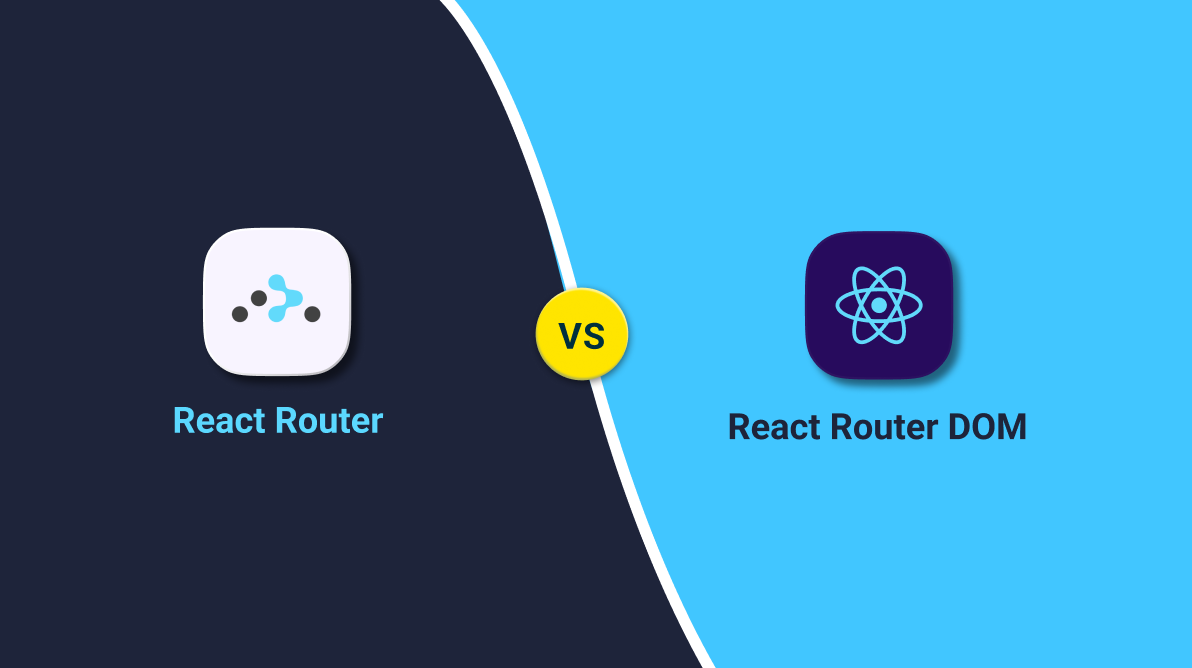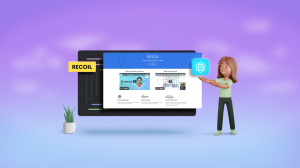TL;DR: React Router and React Router DOM often confuse developers, especially with the release of React Router v7. This guide clarifies their roles, explains how routing works in modern React SPAs, and walks through setup, hooks, and advanced features like nested routing, SSR, and SEO optimization. Learn when to use each package, how to implement dynamic routes, and how Syncfusion® components integrate seamlessly with React Router DOM.
Routing is the backbone of any React SPA, but with React Router v7 and the continued use of React Router DOM, developers often ask: Which one should I use? In this guide, we’ll demystify the differences, walk through setup examples, and share SEO best practices for 2025.
Why is routing essential in React?
React is a leading JavaScript framework for building single-page applications (SPAs), where content updates dynamically without full page reloads. However, React lacks built-in routing, requiring a solution to manage navigation between views. React Router fills this gap by enabling developers to define routes, map URLs to components, and maintain a seamless user experience. In 2025, React Router v7 continues to dominate web development due to its robust features and active community support.

Syncfusion React UI components are the developers’ choice to build user-friendly web applications. You deserve them too.
What is React Router?
React Router is a powerful library for managing navigation in React applications. It synchronizes the user interface with the browser’s URL, allowing developers to define which components to render for specific paths. With the release of React Router v7 in 2024, the library has unified its packages under react-router, simplifying dependency management.
Key packages
react-router:The core library with routing logic, including route-matching algorithms and hooks, suitable for both web and native platforms.react-router-dom:A web-specific package that extends react-router with components like<BrowserRouter>and<Link>. In v7, a re-export of react-router is made for compatibility.react-router-native: Extendsreact-routerfor React Native apps with native-specific APIs.
In v7, react-router consolidates all functionality, but react-router-dom remains widely used for web applications due to its familiar API and extensive documentation.
What is React Router DOM?
React Router DOM is tailored for web applications, providing all the features of react-router plus browser-specific components like <BrowserRouter>, <Link>, and <NavLink>. These components simplify dynamic routing, making it ideal for SPAs running in browsers. In React Router v7, react-router-dom is a re-export of react-router, ensuring compatibility for existing projects while allowing new projects to use react-router directly.
How to use React Router DOM
Step 1: Install the package.
For web applications, install react-router-dom:
npm install react-router-dom@7 For new projects, consider using react-router:
npm install react-router@7 Step 2: Set up the router
Wrap your app with <BrowserRouter> to enable client-side routing:
import { BrowserRouter } from 'react-router-dom';
function App() {
return (
<BrowserRouter>
{/* Routes go here */}
</BrowserRouter>
);
}
export default App;
Step 3: Define routes.
Map URLs to components using <Routes> and <Route>:
import { BrowserRouter, Routes, Route } from 'react-router-dom';
import Home from './components/Home';
import About from './components/About';
function App() {
return (
<BrowserRouter>
<Routes>
<Route path="/" element={<Home />} />
<Route path="/about" element={<About />} />
</Routes>
</BrowserRouter>
);
}
export default App;Step 4: Navigation
Create a navigation bar with <Link>:
import { Link } from 'react-router-dom';
function Navbar() {
return (
<nav className="p-4 bg-gray-100">
<Link to="/" className="mr-4 text-blue-500 hover:underline">Home</Link>
<Link to="/about" className="text-blue-500 hover:underline">About</Link>
</nav>
);
}Step 5: Handle Not Found Pages
Redirect to a 404 page for invalid routes:
import PageNotFound from './components/PageNotFound';
function PageNotFound() {
return (
<div>
<h2>404 - Page Not Found</h2>
<Link to="/">Return to Home</Link>
</div>
);
}
<Routes>
<Route path="/" element={<Home />} />
<Route path="/about" element={<About />} />
<Route path="*" element={<PageNotFound />} />
</Routes>React Router vs. React Router DOM: The Difference
react-router:The core package with essential routing logic, including route matching and hooks, designed for both web and native platforms.react-router-dom:Extends react-router with web-specific components like<BrowserRouter>,<Link>, and<NavLink>. In v7, it’s a re-export of react-router, ensuring compatibility for web developers.
When to Use Which
- Use
react-router-dom:For web applications, especially when upgrading from v6 or preferring its familiar API. It includes all necessary components for browser-based routing. - Use
react-router:For new projects to leverage the unified package structure and future enhancements. It’s also suitable for native apps withreact-router-native.
Since react-router-dom includes react-router as a dependency, there’s no need to install both. For web development in 2025, react-router-dom remains a popular choice due to its ease of use and robust ecosystem.
New Features in React Router v7
React Router v7, released in 2024, introduces several enhancements that improve usability and performance:
- Unified Package Structure: All routing functionality is consolidated under
react-router,simplifying dependencies.react-router-domis maintained as are-exportfor compatibility. - Data Routers: Enable data fetching and mutations directly in routes using loader and
actionfunctions, reducing component complexity:import { createBrowserRouter, RouterProvider } from 'react-router-dom'; import { json } from 'react-router-dom'; const router = createBrowserRouter([ { path: "/user/:id", element: <UserProfile />, loader: async ({ params }) => { const response = await fetch(`/api/users/${params.id}`); return json(await response.json()); }, }, ]); function App() { return <RouterProvider router={router} />; } - Improved TypeScript Support: Enhanced type safety for routes and parameters, ideal for TypeScript projects:
import { useParams } from 'react-router-dom'; interface Params extends Record<string, string> { id: string; } function UserProfile() { const { id } = useParams<Params>(); return <h2>User ID: {id}</h2>; } - React 19 Integration: Leverages React 19’s Suspense for seamless data loading, improving performance in data-heavy apps.
- Server-Side Rendering (SSR) Improvements: Supports partial hydration for faster initial loads in SSR setups.

See the possibilities for yourself with live demos of Syncfusion React components.
Advanced Usability Features of React Router DOM
React Router DOM v7 offers several usability features that make it a top choice for web development:
- Intuitive Components: Components like
<BrowserRouter>,<Routes>,<Route>, and<Link>simplify route setup and navigation, requiring minimal configuration. - Nested Routing: Supports hierarchical layouts for complex applications, such as dashboards, using
<Outlet>:import { Routes, Route, Outlet } from 'react-router-dom'; function Layout() { return ( <div> <h1>Header</h1> <Outlet /> <footer>Footer</footer> </div> ); } function App() { return ( <Routes> <Route path="/" element={<Layout />}> <Route index element={<Home />} /> <Route path="dashboard" element={<Dashboard />} /> </Route> </Routes> ); } - Dynamic Routing: Handles variable data in URLs
(e.g., /user/:id)withuseParams, enabling flexible, reusable routes. - Route Guards: Secures routes with authentication checks, improving app security:
import { Navigate } from 'react-router-dom'; function ProtectedRoute({ children }) { const isAuthenticated = useAuth(); // Assume auth hook return isAuthenticated ? children : <Navigate to="/login" />; } <Route path="/dashboard" element={<ProtectedRoute><Dashboard /></ProtectedRoute>} /> - Lazy Loading: Optimizes performance by loading components on demand with
React.lazyandSuspense:import { lazy, Suspense } from 'react'; const About = lazy(() => import('./About')); <Route path="/about" element={ <Suspense fallback={<div>Loading...</div>}> <About /> </Suspense> } /> - SEO Support: Integrates with SSR frameworks like Next.js and supports dynamic meta tags via
react-helmet:import { Helmet } from 'react-helmet'; function Home() { return ( <div> <Helmet> <title>Home Page</title> <meta name="description" content="Welcome to our React SPA" /> </Helmet> <h1>Home</h1> </div> ); }
Hooks for Routing Logic
React Router v7 provides powerful hooks to simplify routing logic in functional components. These hooks allow developers to access and manipulate routing-related data and behavior without needing to pass props manually. Below are short type descriptions for the key hooks:
useNavigate(): For programmatic navigation. Returns a function to navigate to a new location.useParams(): To access URL parameters. Returns an object of key/value pairs for dynamic route segments.useLocation(): To get current URL info. Returns the current location object, including pathname, search, and state.useMatch(): To match path patterns. Returns the match object for the current route, including path, url, and params.
Example Usage
Here’s how these hooks can be used in a component:
import { useNavigate, useParams, useLocation, useMatch } from 'react-router-dom';
function UserProfile() {
const navigate = useNavigate();
const { id } = useParams();
const location = useLocation();
const match = useMatch('/user/:id');
return (
<div>
<h2>User Profile: {id}</h2>
<p>Current Path: {location.pathname}</p>
<p>Route Match: {match ? 'Matched' : 'Not Matched'}</p>
<button onClick={() => navigate('/home')}>Go Home</button>
</div>
);
}
Explore the endless possibilities with Syncfusion’s outstanding React UI components.
SEO best practices for React Router DOM
SPAs can face SEO challenges due to dynamic content. Optimize with:
- Server-Side Rendering (SSR): Use Next.js or configure SSR with
react-routerto serve pre-rendered HTML. - Dynamic Meta Tags: Update meta tags for each route with
react-helmet(see example above). - Clean URLs: Use descriptive URLs
(e.g., /products/electronics)for better indexing. - Pre-rendering: Generate static HTML for key routes to improve crawlability.
FAQs:
Q1: Does React Router DOM work with Next.js for SSR??
No, you generally should not use react-router-dom with Next.js for server-side rendering (SSR). Next.js has its own built-in routing system based on the file system. You create pages by adding files to the pages/ or app/ directory, and Next.js automatically handles routing.
Q2: Can Syncfusion® components work with React Router DOM?
Yes! Syncfusion’s React components integrate smoothly with routing setups, including nested layouts and dynamic routes.
Q3: What’s the role of hooks like useNavigate and useParams in routing?
These hooks simplify navigation and data access, making routing logic cleaner and more maintainable.
Conclusion
Understanding the differences between react-router and react-router-dom is key to effective routing in React applications. With React Router v7, the unified react-router package simplifies dependency management, while react-router-dom remains a reliable choice for web development. By leveraging advanced features like data routers, nested routing, and powerful hooks like useNavigate, you can build dynamic, performant, and SEO-friendly web applications in 2025.
Have you tried React Router v7? Share your experience in the comments or explore our support forum for more help!
Resources:
The Syncfusion Essential Studio® for React suite offers over 80 high-performance, lightweight, modular, and responsive UI components in a single package. It’s the only suite you’ll ever need to construct a complete app.





Comments (1)
Very clear and helpful comparison of React Router vs React Router DOM you’ve done a great job explaining their roles in v7, how routing works, and when to use each. I particularly liked the deep dive into SEO, nested routing, and hooks. I also came across a related tutorial on adding interactive in React Native Google Maps: https://mobisoftinfotech.com/resources/blog/app-development/react-native-maps-interactive-google-maps-tutorial that one pairs nicely with your post when exploring dynamic front-end and navigation features across platforms.